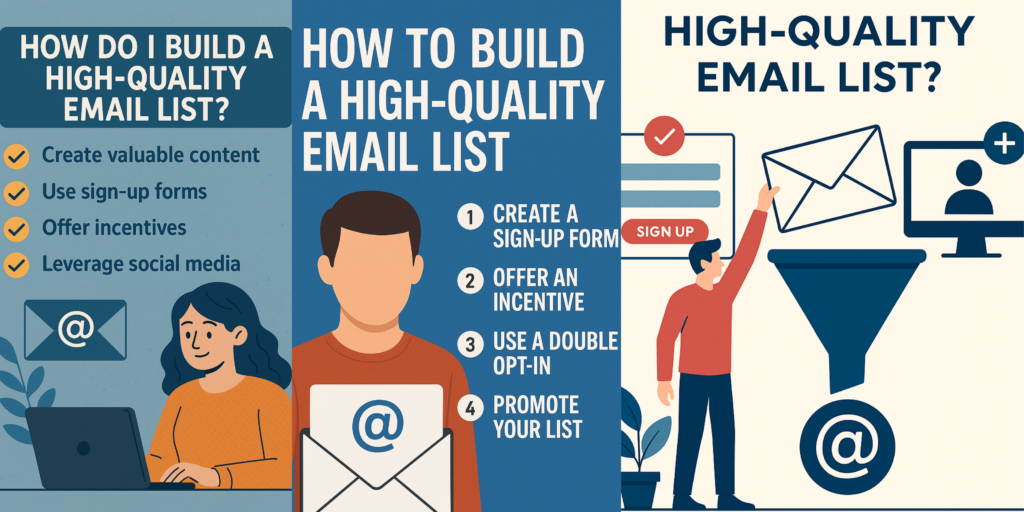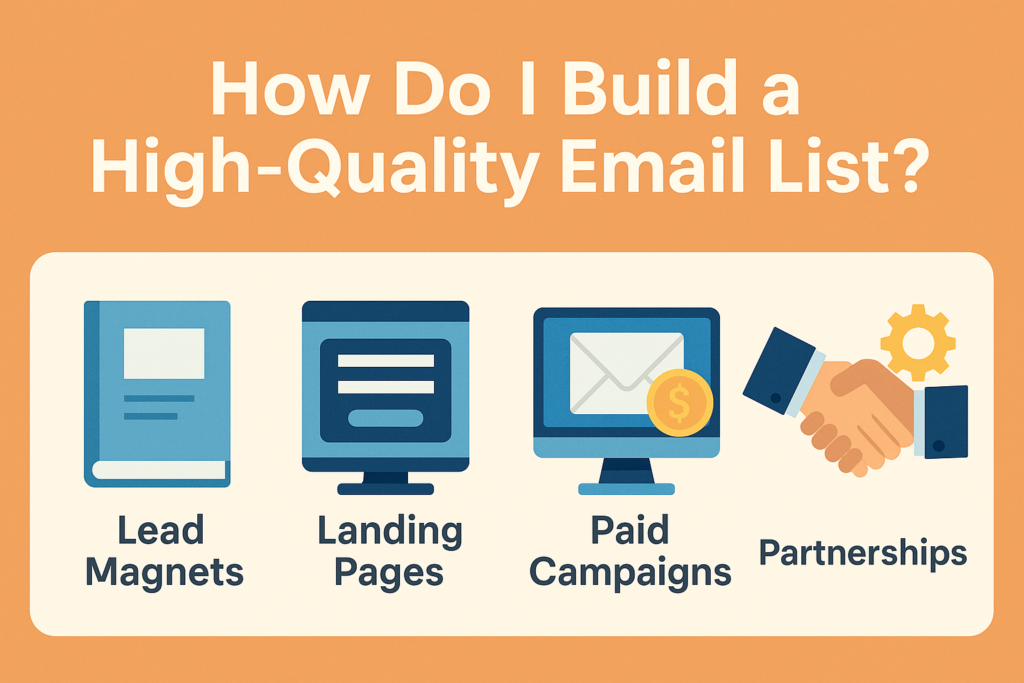Introduction
In today’s digital landscape, email marketing remains one of the most effective channels for nurturing leads, driving conversions, and building long-term customer relationships. However, the foundation of any successful email marketing program is a high-quality email list—an engaged audience who wants to hear from you. Building such a list doesn’t happen by accident; it requires strategy, patience, and ongoing optimization. In this comprehensive guide, we’ll explore step-by-step how to build and maintain a high-quality email list that yields strong open rates, click-throughs, and conversions.

1. Define Your Ideal Subscriber Profile
Before you start collecting email addresses, it’s crucial to know who you want to reach. A targeted list of engaged subscribers is inherently more valuable than a large list of unqualified contacts.
- Create buyer personas. Map out the demographics, interests, pain points, and buying behaviors of your ideal customers.
- Segment by lifecycle stage. Are you targeting cold prospects, existing customers, or brand advocates? Your messaging and lead magnets will differ accordingly.
- Clarify value proposition. Determine the core benefit subscribers will gain by joining your list—exclusive insights, early-bird discounts, educational resources, etc.
By having clear personas and value propositions, you’ll attract subscribers who genuinely care about your content and offerings.

2. Choose the Right Email Marketing Platform
Your email marketing platform (ESP) is the engine that powers your list-building efforts. When selecting an ESP, consider:
- Deliverability rates. Opt for providers with strong reputations to ensure your emails reach inboxes.
- Automation capabilities. Look for features like welcome email series, behavioral triggers, and dynamic content.
- Segmentation tools. The ability to create and manage multiple segments (e.g., by interest, geography, purchase history) is essential for personalization.
- Integrations. Ensure seamless integration with your website CMS, CRM, and other marketing tools (e.g., Facebook Lead Ads, webinar platforms).
Popular options include Mailchimp, ActiveCampaign, Klaviyo, and HubSpot—but choose the one that aligns best with your budget, scale, and feature requirements.
3. Audit and Optimize Your Existing Touchpoints
Even before you launch new campaigns, audit your current digital assets to identify untapped list-building opportunities:
- Website homepage and blog. Place clear, compelling opt-in forms above the fold and at the end of blog posts.
- Sidebar and footer. Utilize these spaces for sign-up prompts, but avoid clutter—keep the focus on a single, strong call-to-action (CTA).
- Pop-ups and slide-ins. When used judiciously (e.g., after a visitor has spent 30 seconds on a page or scrolled halfway), these can significantly boost conversions.
- Social media profiles. Add “Sign Up” buttons on Facebook or include a link to your landing page on Instagram, LinkedIn, and Twitter.
- Offline channels. Collect emails at events, in-store, or during phone interactions, then upload them (with consent) to your ESP.
Regularly test placement, design, and messaging to improve capture rates across all touchpoints.
4. Design High-Converting Landing Pages
While embedding sign-up forms site-wide is useful, a dedicated landing page can dramatically increase conversion rates by removing distractions:
- Clear headline. Communicate the primary benefit of the lead magnet.
- Concise copy. Highlight key takeaways and bullet-point benefits.
- Visual elements. Use an image or mockup of the resource to make it tangible.
- Social proof. Include testimonials or usage stats (“Join 10,000 marketers who downloaded this guide”).
- Minimal form fields. Ask only for essential information—usually just name and email.
- Strong CTA button. Use action-oriented text like “Get My Free Guide” instead of generic “Submit.”
A/B test headlines, images, and form placements to refine performance over time.
5. Utilize Content Upgrades
Content upgrades are “bonus” resources tied to specific blog posts or articles. Because they’re highly targeted, they often generate much higher conversion rates than generic lead magnets.
- Identify top-performing posts. Look for articles with high traffic and engagement metrics.
- Offer a relevant upgrade. For a blog on “5 Instagram Best Practices,” provide an “Instagram Post Planner Template.”
- Implement two-step opt-ins. Use a button that opens a modal form—this friction can increase conversions by committing visitors to the process before asking for their email.
By leveraging the momentum of engaged readers, content upgrades can skyrocket subscription numbers.
6. Run Paid Social and Search Campaigns
Organic methods form the backbone of list-building, but well-targeted paid campaigns can accelerate growth:
- Facebook and Instagram Lead Ads. Capture emails directly within the platform using pre-filled forms.
- LinkedIn Sponsored Content. Target professionals by job title, industry, or company size—ideal for B2B lead magnets like whitepapers.
- Google Ads. Bid on high-intent keywords (e.g., “email marketing guide download”) and direct traffic to your landing page.
- Retargeting. Show ads to website visitors who didn’t subscribe on their first visit, reminding them of your offer.
Set clear cost-per-acquisition (CPA) goals, track performance meticulously, and optimize audiences, ad creative, and bidding strategies to maintain a profitable acquisition cost.
7. Leverage Partnerships and Collaborations
Co-marketing with complementary businesses or influencers can expose your brand to new audiences:
- Guest blogging. Write for industry-relevant sites and include links to your lead magnet.
- Joint webinars or podcasts. Partner with a peer company to co-host an event, sharing both audiences.
- Influencer shout-outs. Offer affiliates or micro-influencers a unique sign-up link and incentive for referring subscribers.
- Email list swaps. If two businesses share similar audiences but are not direct competitors, consider promoting each other’s lead magnets in your newsletters.
Ensure any partnership aligns with your brand values and that audiences overlap meaningfully to maximize conversion quality.
8. Implement Double Opt-In and GDPR Compliance
A high-quality list isn’t just about numbers—it’s about deliverability, engagement, and legal compliance:
- Double opt-in. After the initial sign-up, send a confirmation email requiring subscribers to verify their address. This reduces fake sign-ups and spam complaints.
- Clear privacy policy. Display a link to your data handling practices near every form, in compliance with GDPR and other regulations.
- Unsubscribe ease. Include a one-click unsubscribe link in every email. A clean list of engaged subscribers boosts deliverability and sender reputation.
These measures foster trust, protect your brand’s integrity, and ensure long-term list health.
9. Nurture and Segment Your List
Once subscribers convert, your focus shifts to engagement and retention:
- Welcome email series. Send a sequence of 3–5 emails introducing your brand, sharing valuable content, and guiding subscribers toward a desired action.
- Behavioral triggers. Automate emails based on opens, clicks, website visits, or purchases (e.g., send a product demo if they clicked a feature link).
- List segmentation. Divide subscribers by interests, purchase history, location, or engagement level. Tailored messaging yields higher open and click rates.
- Regular content. Balance promotional emails with educational content, industry insights, or user-generated stories to maintain interest.
- Re-engagement campaigns. For inactive subscribers (e.g., no opens in 3–6 months), send a “We miss you” series with exclusive offers or content upgrades.
Personalization and relevance are key—generic blasts erode trust and prompt unsubscribes.
10. Monitor Performance and Clean Your List
Continuously track key performance indicators (KPIs):
- Subscription rate. New subscribers per week or month.
- Open rate. Percentage of recipients who open your emails.
- Click-through rate (CTR). Percentage who click on links.
- Conversion rate. Percentage who complete a desired action (purchase, signup, download).
- Unsubscribe and spam complaint rates. Indicators of content misalignment or frequency issues.
Every 3–6 months, run a list hygiene process:
- Remove hard bounces. Emails that permanently can’t be delivered.
- Suppress soft bounces. After multiple soft bounces, temporarily suppress to protect sender reputation.
- Purge inactive subscribers. Consider deleting contacts who haven’t engaged in 6–12 months, or move them to a “cold” segment for occasional outreach.
A lean, engaged list outperforms a bloated one in deliverability and ROI.
11. Case Study: From 500 to 5,000 Subscribers in 6 Months
Background: A UAE-based electronics retailer aimed to grow its email list ahead of a major product launch.
Strategy:
- Developed a comprehensive “Smart Home Setup Guide” as an eBook.
- Created a dedicated landing page promoted via Facebook Lead Ads with geo-targeting across Dubai and Abu Dhabi.
- Implemented content upgrades on tech blog posts (e.g., “Top 10 Home Automation Tips”).
- Partnered with a prominent local tech influencer for an Instagram Live event, sharing a unique sign-up link.
Results:
- Initial List: 500 subscribers
- 6-Month Growth: +4,500 subscribers (900% increase)
- Average CPL: AED 6 (US$1.60)
- Open Rate: 38%
- Sales Lift: 12% increase in product launch pre-orders
Key takeaway: a targeted lead magnet coupled with paid campaigns and influencer collaborations can accelerate high-quality list growth.
13. Advanced Tactics
For marketers ready to take list-building to the next level:
- Progressive profiling. Gradually collect more information over time using preference centers, rather than asking for everything at once.
- Interactive content. Integrate calculators, quizzes, or surveys that require an email for results.
- SMS-to-email flows. Capture mobile numbers first, then drive subscribers to email sign-ups via SMS campaigns.
- Predictive lead scoring. Use AI-driven tools to identify subscribers most likely to convert, focusing nurturing efforts accordingly.
- API-based integrations. Automate subscriber capture from chatbots, CRM updates, and point-of-sale systems in real time.
These techniques demand more sophisticated infrastructure but can yield exponential returns.
Conclusion
Building a high-quality email list is a cornerstone of modern digital marketing. By defining your ideal subscriber, crafting compelling lead magnets, optimizing every touchpoint, and nurturing your audience with relevant content, you’ll cultivate a responsive, engaged list that drives sustainable business growth. Remember, list-building is an ongoing process—test, analyze, and iterate to continually refine your approach. With strategic planning and consistent execution, you can transform email from a simple channel into a powerhouse revenue generator.